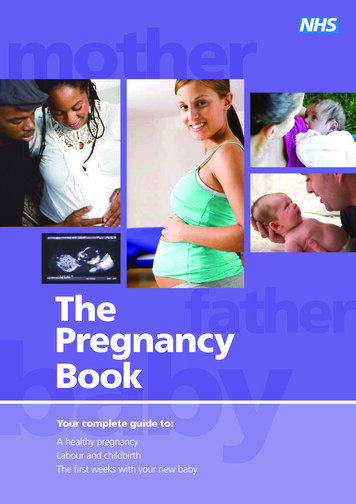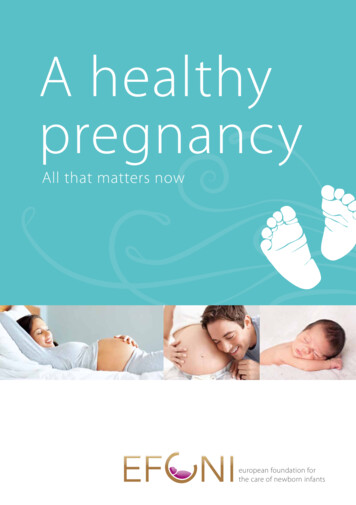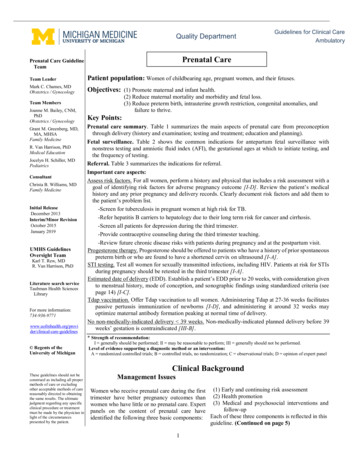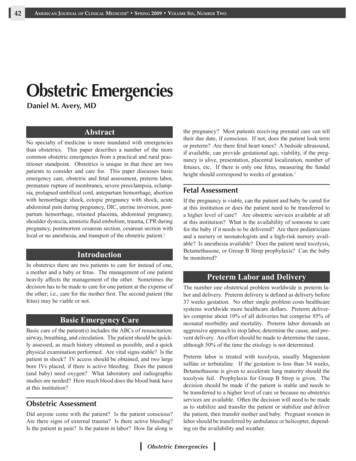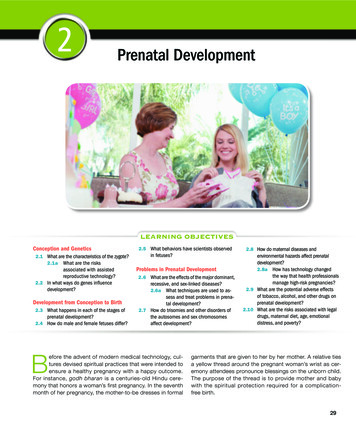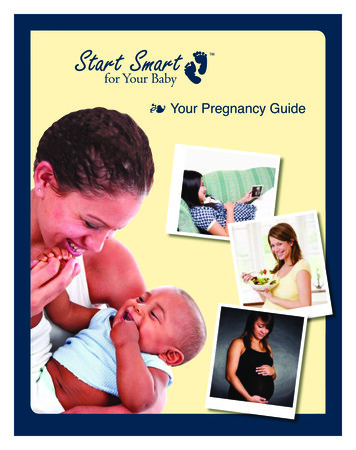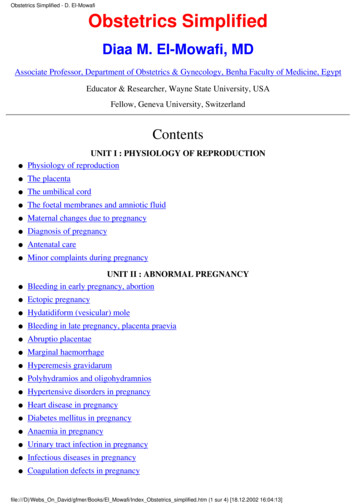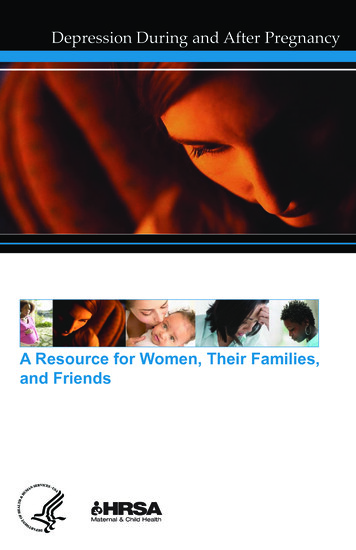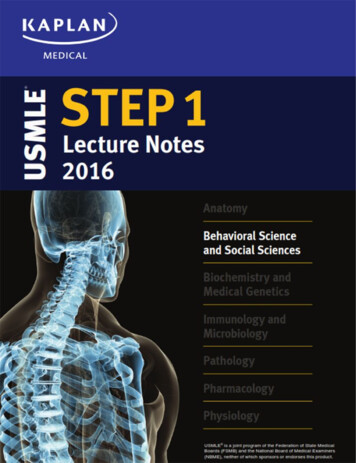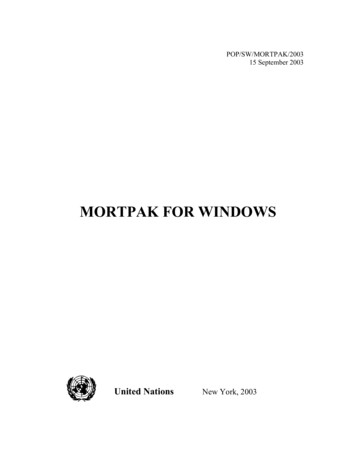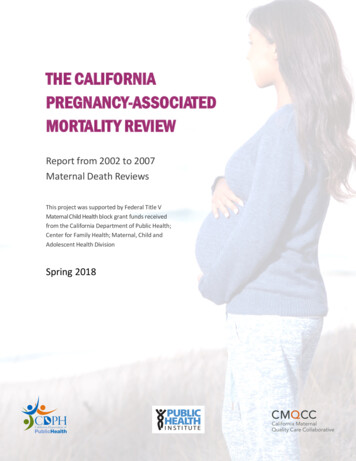
Transcription
THE CALIFORNIAPREGNANCY-ASSOCIATEDMORTALITY REVIEWReport from 2002 to 2007Maternal Death ReviewsThis project was supported by Federal Title VMaternal Child Health block grant funds receivedfrom the California Department of Public Health;Center for Family Health; Maternal, Child andAdolescent Health DivisionSpring 2018(This page left intentionally blank)
2TABLE OF CONTENTS1. Acknowledgements .4The California Pregnancy–Associated Mortality Review Committee .52. Executive Summary .73. Background and Methods .10Methodology .11Key Definitions.124. Findings . 13Pregnancy-Associated Deaths, California Residents; 2002-2007 .14Pregnancy-Related Deaths, California Residents; 2002-2007 .16Causes of Pregnancy-Related Deaths, per CA-PAMR Committee . 16Timing of Pregnancy-Related Deaths. 22Demographic and Social Characteristics of Women Who Died .23Coroner Reports and Autopsies .26Maternal Characteristics of Pregnancy and Delivery. 27Medical Risk Factors of Women Who Died. 31Social Risk Factors and Racial/Ethnic Disparities. 335. Preventability of Pregnancy-Related Deaths. 36Overall Preventability .37Contributing Factors .38Quality Improvement Opportunities.436. Implications and Recommendations . 521. Continue Maternal Mortality Case Reviews .532. Improve Data Collection and Analysis.543. Anticipate More Women Entering Pregnancy with Chronic Health Conditions.554. Integrate Assessment of Social Factors Impacting Pregnancy .565. Address Provider and Facility Factors through Ongoing Maternity Care QualityImprovement .587. Translation Activities . 60California Maternal Quality Care Toolkits Informed by CA-PAMR .61National Initiatives.638. The Rise and Fall of Maternal Mortality Rates in California . 66What Caused the Rise in Maternal Mortality? .68What Is Contributing to the Decline in California Maternal Mortality?.71References . 77Appendix: Technical Notes . 80Spring 2018
3List of FiguresFigure 1: Case Ascertainment of Pregnancy-Related Deaths, CA-PAMR, 2002-2007 . 14Figure 2: Causes of Pregnancy-Associated Deaths, per Death Certificate (n 1,059), 2002-2007. 15Figure 3: Classification of Pregnancy-Related Cardiovascular Deaths, CA-PAMR, 2002-2007 . 18Figure 4: Timing of Major Causes of Pregnancy-Related Death, CA-PAMR, 2002-2007 . 22Figure 5: Age Group Distribution among CA-PAMR Deaths and California Birth Cohort, 2002-2007 . 24Figure 6: Racial/Ethnic Distribution among CA-PAMR Deaths and California Birth Cohort, 2002-2007 . 25Figure 7: Maternal BMI among CA-PAMR Deaths and California Women Giving Birth, 2002-2007 . 27Figure 8: Maternal BMI among Major Causes of Pregnancy-Related Death, CA-PAMR, 2002-2007 . 28Figure 9: Chance to Alter Outcome among Pregnancy-Related Deaths, CA-PAMR, 2002-2007. 38Figure 10: Health Care Provider Factors Contributing to Pregnancy-Related Deaths, CA-PAMR,2002-2007. 40Figure 11: Facility Factors Contributing to Pregnancy-Related Deaths, CA-PAMR, 2002-2007 . 40Figure 12: Patient Factors Contributing to Pregnancy-Related Deaths, CA-PAMR, 2002-2007. 41Figure 13: Maternal Mortality Rates, California Residents and U.S., 1999-2008 . 67Figure 14: Disparities in Maternal Mortality Rates by Race/Ethnicity, California Residents, 1999-2008 . 67Figure 15: Maternal Mortality Rates, California Residents and U.S., 1999-2013 . 72Figure 16: Disparities in Maternal Mortality Rates by Race/Ethnicity, California Residents, 1999-2013 . 73Figure 17: Early, Late and Total Maternal Mortality, California Residents, 1999-2013 . 75List of TablesTable 1: Clinical Causes of Pregnancy-Related Deaths, per CA-PAMR Committee, 2002-2007 . 17Table 2: Pregnancy-Related Mortality Rates by Race/Ethnicity among All Causes ofPregnancy-Related Death, CA-PAMR, 2002-2007 . 21Table 3: Demographic Characteristics of CA-PAMR Pregnancy-Related Deaths and California BirthCohort, 2002-2007 . 23Table 4: Maternal Characteristics of Pregnancy and Delivery among Major Causes of Pregnancy-RelatedDeath, CA-PAMR and California Birth Cohort, 2002-2007. 30Table 5: Risk Level, Mode and Circumstances of Delivery among Major Causes of Pregnancy-RelatedDeath, CA-PAMR, 2002-2007. 32Table 6: Social Risk Factors among Pregnancy-Related Deaths, CA-PAMR, 2002-2007 . 34Table 7: Mode of Delivery among Pregnancy-Related Deaths, CA-PAMR, 2002-2007 . 42Table 8: Prevalence of Maternal Morbidity among California Hospital Deliveries, 2002-2007 . 69 2017 California Department of Public Health. The material in this report may be reproduced anddisseminated in any media in its original format, without modification, for information, educational,and non-commercial purposes only.Suggested citation: The California Pregnancy-Associated Mortality Review. Report from 2002-2007Maternal Death Reviews. Sacramento: California Department of Public Health, Maternal, Child andAdolescent Health Division. 2017CA-PAMR Report from 2002 to 2007 Maternal Death Reviews
41. AcknowledgementsThe California Pregnancy-Associated Mortality Review (CA-PAMR) requires the work and support ofmany people who deserve acknowledgement. The California Department of Public Health (CDPH), andthe Maternal, Child and Adolescent Health (MCAH) Division provided leadership to sound the alarmand act to address rising rates of maternal deaths. We thank the following for their leadership: ShabbirAhmad, DVM, MS, PhD, Chief of MCAH Epidemiology, Surveillance and Federal Reporting Branch, LeslieKowalewski, Chief of MCAH Division, Connie Mitchell, MD, MPH, Deputy Director of the Center forFamily Health, and Karen L. Smith, MD, MPH, Director of CDPH.We gratefully acknowledge our colleagues who work with national and state maternal mortality reviewprograms for their support and the generous sharing of expertise and resources. We especially thankCynthia Berg, William Callaghan, David Goodman, Julie Zaharatos, Andria Cornell, and Michael Lu fortheir assistance. Gwyneth Lewis from the United Kingdom also has been very helpful to our work.We extend our gratitude to the many doctors, nurses, midwives and other health professionals whohave volunteered considerable time and expertise to the CA-PAMR Committee to review the medicalrecords of women who died. The following page lists the names of the Committee members and theiraffiliation at time of service. Each has shown remarkable dedication and concern for improving thehealth and health care of mothers in California.We sadly acknowledge the women who died during or after their pregnancies, the families who loveand miss them, and the clinicians who cared for them. Each maternal death in this report represents awoman whose life ended early. This report seeks to honor the memories of these women by improvingthe experience of expectant mothers everywhere.Funding for CA-PAMR is provided through the federal Title V Maternal and Child Health (MCH) BlockGrant and relies upon the successful partnership of three organizations and their current and formerstaff:California Department of Public Health; Maternal, Child, and Adolescent Health (MCAH)Elizabeth Lawton, MHS, Amina Foda, MPH, Mike Curtis, PhDCalifornia Maternal Quality Care Collaborative (CMQCC)Elliott Main, MD, Christine Morton, PhD, Jeffrey Gould, MD, MPHPublic Health Institute (PHI)Sue Holtby, MPH, Christy McCain, MPH, Ann Kristienne McFarland, CNM,NP,RN, KathleenGreen-Barbour, RN, Karene Matterson, RN, Delphina AlvarezSpring 2018
5The California Pregnancy–Associated Mortality Review CommitteeCurrent MembersAffiliations at time of California Pregnancy–Associated Mortality Review Committee serviceElliott Main, MD, ChairCalifornia Pacific Medical Centerand California Maternal QualityCare Collaborative (MaternalFetal Medicine)Elyse Foster, MDUniversity of California, SanFrancisco, School of Medicine(Cardiology)Kristi Gabel, RNC, MN, CNSDeirdre Anglin, MD, MPHRegional Perinatal Programs ofUniversity of Southern California, California, Region 2Keck School of Medicine(Sacramento) (Obstetric and(Emergency Medicine)Neonatal Nursing)Conrad Chao, MDUniversity of California, SanFrancisco, Fresno MedicalEducation Program, CommunityRegional Medical Center(Maternal Fetal Medicine)Dodi Gauthier, MEd, RNCAssociation of Women’s Health,Obstetric and Neonatal Nursesand Santa Barbara CottageHospital (Obstetric and NeonatalNursing)Maurice Druzin, MDStanford University MedicalCenter, Lucile Packard Children’sHospital (Maternal FetalMedicineKimberly Gregory, MD, MPHUniversity of California, LosAngeles, David Geffen School ofMedicine and Cedars SinaiMedical Center (Maternal FetalMedicine)Michael Fassett, MDKaiser Permanente West LosAngeles Medical Center andKaiser Permanente Bakersfield(Maternal Fetal Medicine)Edward Riley, MDStanford University MedicalCenter, Lucile Packard Children’sHospital (Anesthesia)Larry Shields, MDDignity Health, Marian RegionalMedical Center, Santa Maria(Maternal Fetal Medicine)Afshan Hameed, MD, FACOG,FACCUniversity of California, Irvine,School of Medicine (Cardiology,Maternal Fetal Medicine)Thomas Kelly, MDUniversity of California, SanDiego School of Medicine(Maternal Fetal Medicine)Nathana Lurvey, MDSouthbay Family HealthcareCenter and ACOG, District IX(Obstetrics and Gynecology)Natalie Martina, CNM, MSNAlta Bates Medical Center (NurseMidwifery)Barbara Murphy, MSN, RNStanford University School ofMedicine, California PerinatalQuality Care Collaborative andCalifornia Maternal Quality CareCollaborative (Obstetric andNeonatal Nursing)Larry Newman, MD, FACOGKaiser Permanente, OaklandMedical Center (Maternal FetalMedicine)Lucy Van Otterloo, PhD, MSNCommunity Perinatal Network,Yorba Linda and California StateUniversity, Long Beach (Obstetricand Neonatal Nursing)Marla Seacrist, PhD, RNCCalifornia State University,Stanislaus (Obstetric andNeonatal Nursing)CA-PAMR Report from 2002 to 2007 Maternal Death Reviews
6Former MembersAffiliations at time of California Pregnancy–Associated Mortality Review Committee serviceLisa Berry, MSN, RNCAssociation of Women’s Health,Obstetric and Neonatal Nurses(Obstetric and Neonatal Nursing)Sheila E. Cohen, MB.Ch.B, FRCAStanford University School ofMedicine, Lucile PackardChildren’s Hospital (Anesthesia)Debra Bingham, DrPH, RNStanford University School ofMedicine and CaliforniaMaternal Quality CareCollaborative (Obstetric andNeonatal Nursing)Patricia Dailey, MDAnesthesia Care AssociatesMedical Group, Burlingame(Anesthesia)Linda V. Walsh, CNM, PhD,FACNMUniversity of San Francisco,School of Nursing (NurseMidwifery)Jeffrey B. Gould, MD, MPHStanford University School ofMedicine, California PerinatalQuality Care Collaborative andKatherine Gregory, MD, MPHCalifornia Maternal Quality CareACOG, District IX (Obstetrics and Collaborative (Neonatology)D. Lisa Bollman, MSN, RNC,Gynecology)CPHQMargaret “Lynn” Yonekura, MDRegional Perinatal Programs ofCarolina Reyes, MDCalifornia Hospital MedicalCalifornia Region 6.7, (Whittier) University of Southern California Center (Obstetrics and(Obstetric and Neonatal Nursing) Keck School of Medicine, and Los Gynecology)Angeles Best Babies (Obstetricsand Gynecology)Spring 2018
72. Executive SummaryMaternal deaths are uncommon, yet as sentinel events, serve as a call to action for public healthprofessionals and maternity care clinicians. California observed its maternal mortality rate rise sharplyfrom 8.0 deaths per 100,000 live births in 1999 to 16.9deaths per 100,000 live births in 2006. This prompted theOver 1,000 women died,California Department of Public Health, Maternal, Child,from all causes, duringand Adolescent Health Division to invest Title V Maternalchildbirth or within one year of aand Child Health (MCH) Block Grant funds in a variety oflive birth or fetal death fromactivities to investigate and improve maternity care and2002 through 2007.maternal health outcomes.A cornerstone activity to address maternal mortality was the establishment of the California Pregnancy-Associated Mortality Review (CA-PAMR). CA-PAMR is a statewide examination of maternal deathsusing enhanced public health surveillance methodology and in-depth medical record review by anexpert, multidisciplinary committee of maternity care and public health professionals. The major goalsof the project are to identify pregnancy-related deaths, their causes, associated risks, and preventionopportunities, and then recommend improvements in the quality of maternity care and public healthprograms and surveillance.This report presents comprehensive and detailed findings of maternal deaths, with an emphasis on theseven leading causes of pregnancy-related deaths in California. Over 1,000 women died, from allcauses, during childbirth or within one year of a live birth or fetal death from 2002 through 2007. Ofthese, the Committee determined that 333 deaths were pregnancy-related, defined as a death directlyrelated to physiologic changes of pregnancy or from causes aggravated by the pregnancy or itsmanagement.Key findings from the CA-PAMR investigation include: Cardiovascular disease was the leading cause of pregnancy-related death. Prior to the CAPAMR review, and relying on death certificates alone, preeclampsia would have beenidentified as the leading cause of pregnancy-related death. Racial disparities persist. CA-PAMR confirmed that African-American women continue to die atthree-to-four times the maternal mortality rate of women of other racial/ethnicities groups,and as high as eight times the rate when deaths from pregnancy-related cardiovascular diseaseis considered. In most cases, multiple patient, facility, and health care provider factors contributed to thepregnancy-related deaths. Common factors included co-morbidities, especially obesity andhypertension, delayed recognition of and response to clinical warning signs, and a lack ofinstitutional readiness for obstetric emergencies.CA-PAMR Report from 2002 to 2007 Maternal Death Reviews
8 Forty-one percent of the pregnancy-related deaths had a good-to-strong chance ofpreventability.The major recommendations arising from this in-depth examination are: Improvements in public health data collection used in maternal mortality case review willenhance California’s ability to monitor maternal mortality and develop evidence-basedrecommendations to prevent its occurrence. Providers of maternity care and reproductive health counseling need to be vigilant aboutwomen entering pregnancy with chronic health conditions, including obesity, and in helpingthem to attain optimal health by the time of pregnancy. Social and economic factors need to be taken into account when evaluating effective care andin anticipating the health needs of pregnant and postpartum women. Clinicians caring for African-American women need to have a heightened sense of awarenessof risk factors among this group, such as potential cardiovascular symptoms or obesity. Quality improvement opportunities for both providers and hospital facilities were identified,including implementation of standardized protocols, effective planning and bettercommunication, and appropriate use of obstetric procedures, e.g., labor induction andcesarean sections. Better communication and coordination within and across hospital departments wherepregnant and postpartum women seek care, especially between emergency and obstetricdepartments, is necessary.CA-PAMR was designed to inform and translate findings into strategies to reduce preventable maternalmortality and morbidity. The six years of CA-PAMR case review have informed the development of aseries of California Maternity Quality Improvement Toolkits to assist and guide maternity clinicians andbirth facilities to improve their readiness, recognition, and response to preventable causes of maternalmortality and morbidity. Four toolkits focusing on obstetric hemorrhage, preeclampsia, cardiovasculardisease, and venous thromboembolism have been released and implemented at more than 150hospitals in California.After investigating maternal deaths occurring from 2002 through 2007, the rise from 1999 to 2006 waslargely attributable to three factors:1) Better documentation of maternal deaths on the death certificate2) Women entering pregnancy at an older age and with a greater incidence of chronic conditionsand significant social risk factors3) Significant need for improvement in clinician and facility readiness to respond to certainobstetric complicationsSpring 2018
9Since 2008, California has experienced an impressive decline in maternal mortality to a low of 7.3deaths per 100,000 live births in 2013 from the high of 16.9 deaths per 100,000 live births in 2006. Thisis in stark contrast to the nation where maternal mortality rates are triple those of California andappear to be increasing. The decline in maternal mortality in California likely reflects the collectiveimpact of public health investments in maternal health programs and enhanced surveillance coupledwith strong engagement and leadership among California maternity care hospitals, providers, insurers,and advocacy organizations to implement quality improvement initiatives.California is committed to maintaining the momentum toward improved maternal health outcomes forCalifornia women and their families, which includes maternal mortality review. The findings can beapplied to known areas for improvement, such as preeclampsia, as well as to respond to other areas ofneed, such as maternal suicides and mental health issues among pregnant and postpartum women.Improvements in the timeliness of mortality reviews are needed so that the prevalence of potentialpregnancy-related deaths from specific infectious causes (e.g., Zika) and emerging issues such as thecurrent opioid addiction epidemic, can be monitored and addressed. Finally, while California has seendeclines in maternal deaths up to 42 days postpartum, public health needs to better understand andaddress the concerning rise in maternal deaths occurring later in the late postpartum period (between43 and 365 days). This may be a national phenomenon deserving of routine monitoring for all states.I experienced postpartum hemorrhage andemergency hysterectomy after the birth of mysecond child. In medical terms this is called anear miss For me, this ‘near miss’ was anemotional, physical and spiritual ordeal, whichtore my life and body apart--symbolically andliterally—for months and years afterward. Whathappened to me is a tragedy.- A California momCA-PAMR Report from 2002 to 2007 Maternal Death Reviews
BACKGROUND ANDMETHODSCalifornia views maternal deaths as sentinel events, which need to be thoroughlyinvestigated. There are two goals for state reviews of maternal death.The first is surveillance, to monitor the population’s health. Thesecond is to use the results to inform quality improvement.The critical lessons and recommendations from thisreview have been applied to improvements inpopulation health, clinical care and healthcare policy for California’s womenand their families.Karen L. Smith, MD, MPHDirector and State Public Health OfficerCalifornia Department of Public Health(This page left intentionally blank)
113. Background and MethodsAims and Objectives of the California Pregnancy-Associated Mortality ReviewThe California Pregnancy-Associated Mortality Review started in 2006 to identify possible reasons forthe rise in maternal mortality, increase in racial/ethnic disparities, and to develop evidence-informedclinical, policy and programmatic interventions.Methodology Data sources, case ascertainment methodology and confidentiality are described in detail inthe Appendix: Technical Notes and in the previous CA-PAMR report (2011).1 The CA-PAMR Committee (the Committee) is a multidisciplinary group comprised of experts innursing, obstetrics, maternal-fetal medicine, midwifery, cardiology, anesthesiology, emergencymedicine, public health, and sociology. Committee members reviewed de-identified casesummaries with detailed synopses of available hospital and outpatient medical records fromthe prenatal period up to the death, as well as autopsy and coroner reports. For each case, the Committee determined via consensus whether the death was pregnancyrelated, causes of death, contributing factors, chance to alter outcome and opportunities forquality improvement.oCauses of death were categorized into 12 diagnosis groups, one of which was “other.”These categories mirror those used by the Centers for Disease Control and Prevention andthe United Kingdom (UK) Confidential Enquiry to allow for external comparisons. 2,3 In caseswith two or more major diagnoses, the Committee selected the diagnosis group based onthe underlying disease process that initiated the series of clinical events that initiated thecascade toward death.oContributing factors fell into the following three categories: provider, facility, andpatient. Healthcare provider factors include actions involving diagnosis, treatment, andcommunication processes. Facility factors include systems-level processes involvingpolicies, nursing knowledge, or infrastructure. Patient factors include circumstances, riskfactors or health behaviors contributing to the cause of death.oPreventability, or the chance to alter the fatal outcome, was categorized as 1) strong, 2)good, 3) some, or 4) none. A case was considered to have a strong or good chance to alterthe outcome when specific and feasible actions, if implemented, might have changed thecourse of the woman’s disease trajectory and potentially prevented the death.oQuality improvement opportunities, defined as alternative approaches to recognition,diagnosis, treatment or follow-up, which, if implemented, may have led to better patientcare or a better outcome.CA-PAMR Report from 2002 to 2007 Maternal Death Reviews
12KEY DEFINITIONSPregnancy-related deathA pregnancy-related death is from causes directly related to physiologic changes ofpregnancy (direct obstetrical death) or from causes aggravated by the pregnancy or itsmanagement (indirect obstetrical death). If a woman dies while pregnant or within oneyear of termination of a pregnancy from causes unrelated to pregnancy or its management(e.g., injuries or complications of other conditions) then the death is defined asnot-pregnancy-related. When pregnancy-related deaths and not-pregnancy-related deathsare combined, the whole group is referred to as pregnancy-associated deaths.Note: Deaths of women who were less than 20 weeks pregnant were not included becausea fetal death certificate is usually not issued unless the fetal loss occurs after 20 weeks,compromising the ability to perform the birth/death data linkage used to identify cases.Maternal mortality rateThe maternal mortality rate is derived from death and birth certificate data and is definedas the number of women who die from a pregnancy-related cause within 42 dayspostpartum (numerator) divided by the number of live births in that year (denominator)multiplied by 100,000. See Technical Notes for specific codes included in the numerator.Note: This measure is sometimes referred to as the maternal mortality ratio.Pregnancy-related mortality rateThe pregnancy-related mortality rate is defined as the number of women who die from apregnancy-related cause up to one year postpartum (numerator) divided by the numberof live births in that year (denominator) multiplied by 100,000. Therefore, the differencebetween maternal mortality and pregnancy-related mortality rates is the time period forinclusion (deaths up to 42 days postpartum versus deaths up to one year postpartum).Note: The CDC uses the following definition of pregnancy-related mortality: The death ofa woman while pregnant or within one year of termination of pregnancy, irrespective ofthe duration and site of the pregnancy, from any cause related to or aggravated by herpregnancy or its management, but not from accidental or incidental causes.Spring 2018
FINDINGSAs we reviewed these tragic cases, we grieved women’s deaths, and for theongoing impact of this loss on their loved ones, their communities andCalifornia. We also vowed to act on these findings to improvematernal care for all women, by strengthening clinicalpractices and public health programs, and sustainingthose improvements into the future.Kristi Gabel, RNC, MN, CNSRegional Perinatal Programs of CaliforniaRegion 2, Sacramento(This page left intentionally blank)
144. FindingsPregnancy-Associated Deaths, California Residents; 2002-2007There were 3,310,485 live births in California during this time period (approximately 12% of all U.S.births) and 1,059 of these were identified as pregnancy-associated deaths (i.e., death of a womanwhile pregnant or within one year of the end of pregnancy, from any cause). All pregnancy-associateddeaths were screened using a team-developed algorithm to identify likely pregnancy-related deaths(i.e., either directly related to pregnancy or aggravated by the pregnancy management) that wouldthen be selected for case review. The algorithm scanned for timing of death, the underlying cause ofdeath on the death certificate and additional medical information from text fields on the deathcertificate (e.g., multiple cause of death, recent surgeries, or notes) or from coroner reports. Of these,427 received full review by the CA-PAMR Committee to determine if the death was pregnancy-relatedand to learn about possible preventability or other contributors to the fatal outcome. The Committeedetermined that 333 (78%) of 427 deaths reviewed were determined to be pregnancy-related(Figure 1).Figure 1: Case Ascertainment of Pregnancy-Related Deaths, CA-PAMR, 2002-2007Approximately one-third of the pregnancy-associated deaths using death certificate data (prior toCA-PAMR review) were from obstetric causes, e.g., had an International Classification of Disease, 10threvision (ICD-10) code on the death certificate from the obstetric chapter and which were designatedby an ‘O’ prefix before the specific disease code (referred to as “O codes” hereafter). See the TechnicalNotes for a listing of specific O codes. Another third were reported on the death certificate as nonSpring 2018
15obstetric, medical causes, with the remaining deaths from violent or accidental causes (Figure 2). TheICD-10 codes used to group causes of death are specified in the Technical Notes.Among the non-obstetric deaths (n 731), the leading causes of death as reported on the deathcertificate were: Other medica
Family Health, and Karen L. Smith, MD, MPH, Director of DPH. We gratefully acknowledge our colleagues who work with national and state maternal mortality review programs for their sup

